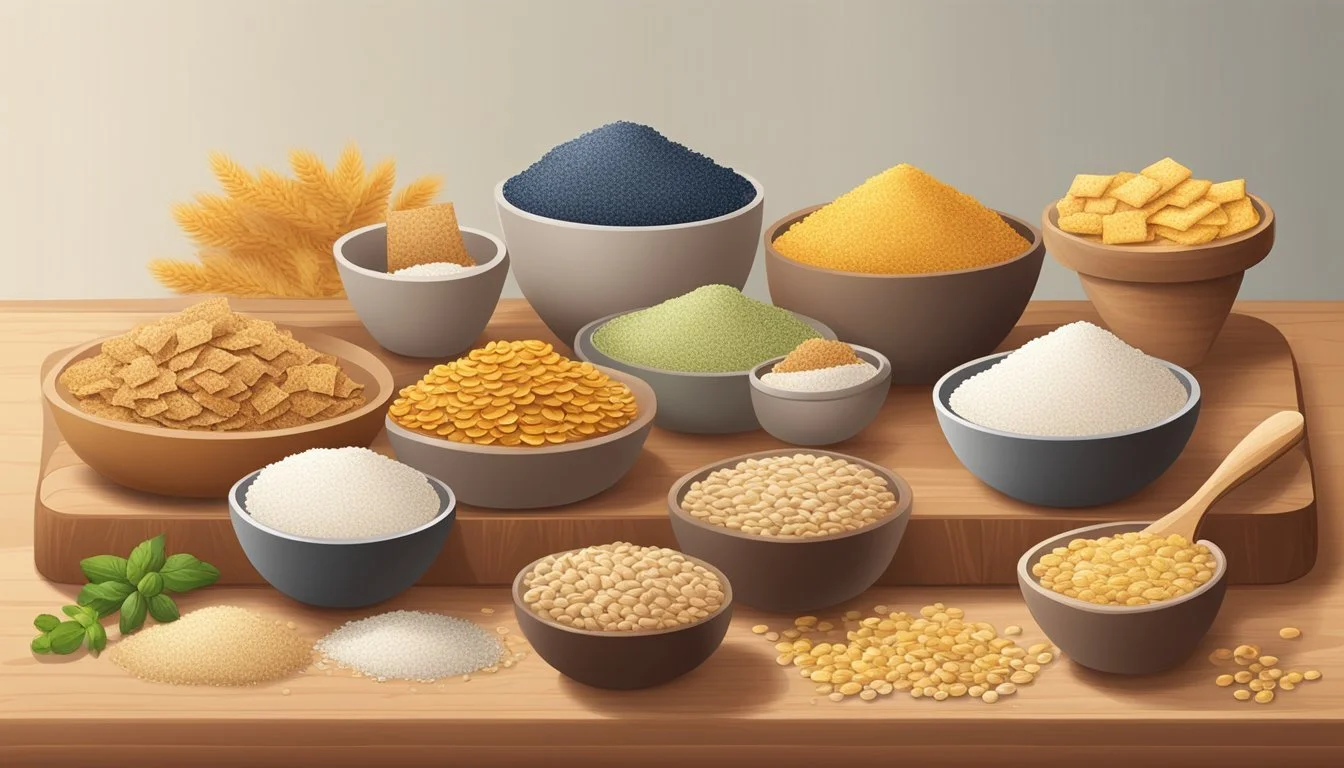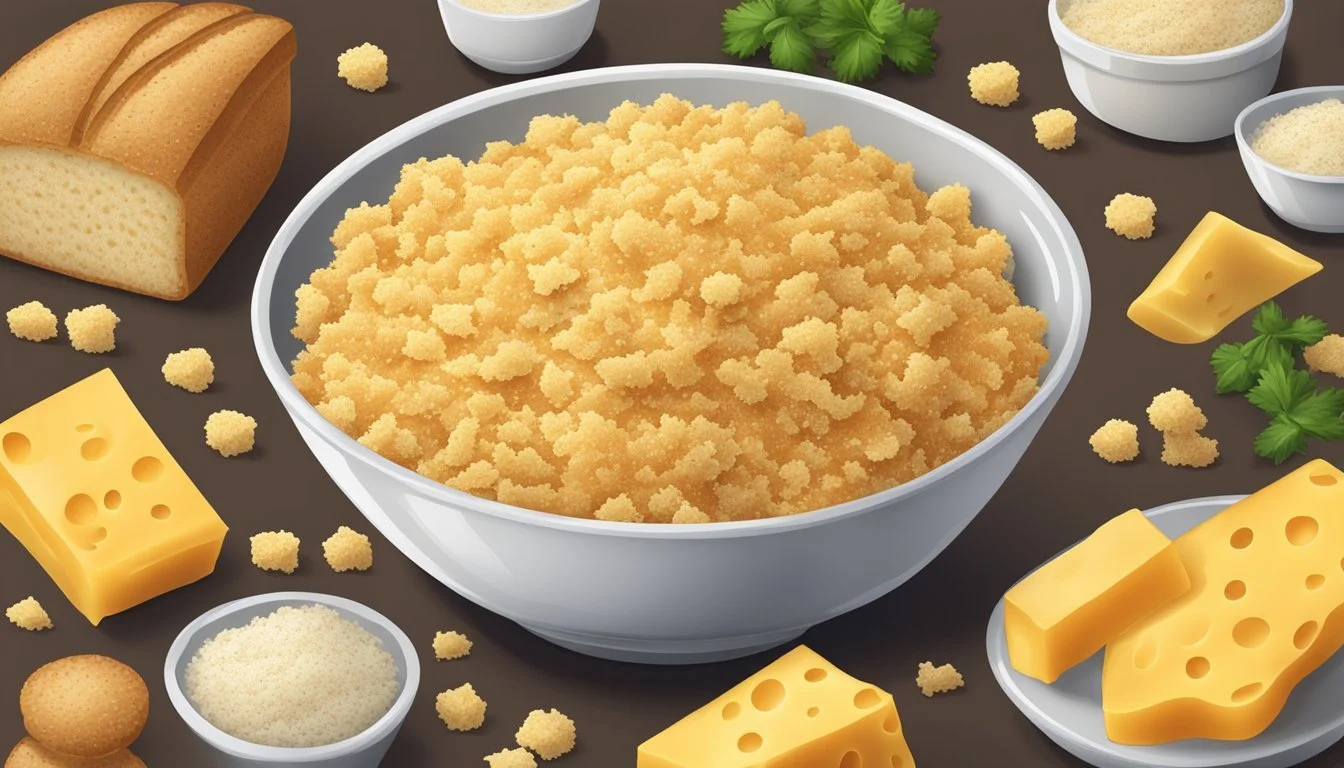Breadcrumbs Substitutes
Top Alternatives for Your Recipes
Breadcrumbs are a staple in many kitchens, used for their versatility and ability to add a satisfying crunch to various dishes. They are commonly used as a binding agent in patties and meatballs, as a stuffing base, and as a crispy topping or coating for baked or fried foods. However, dietary preferences and restrictions, as well as unexpected shortages, might necessitate the search for alternative ingredients that can mimic the texture and binding qualities of traditional breadcrumbs.
Fortunately, several suitable substitutes serve well in place of breadcrumbs. Cooked rice, for instance, can act as an effective binder in recipes like meatloaf or veggie burgers, though it does not provide a crunchy exterior ideal for frying. Rolled oats, crushed into finer particles, offer a healthy, fiber-rich alternative, especially when flavor is enhanced with seasonings. For those adhering to a gluten-free diet, crushed tortilla chips or various nuts like almonds can be a flavorful and texturally appealing replacement capable of delivering the desired crunch in coatings for meats and vegetables.
Understanding Breadcrumbs
In the culinary arts, breadcrumbs are more than a mere afterthought; they play pivotal roles in both texture and flavor enhancement. They are a versatile ingredient utilized across various cuisines and preparations.
Roles of Breadcrumbs in Cooking
Breadcrumbs are primarily used to add a crunchy texture to dishes. When baked or fried, their ability to brown and attain a crispy quality makes them ideal for coating foods like chicken schnitzel or topping casseroles (What wine goes well with casseroles?). In meatballs or meatloaves, breadcrumbs are used to bind ingredients together, ensuring the mixture holds its form while cooking.
They can also absorb excess moisture, which is particularly useful in preventing stuffed vegetables or stuffed meats from becoming soggy. Moreover, breadcrumbs help to distribute flavors evenly throughout a dish, as they can carry spices and herbs within their crumbly matrix.
Nutritional Benefits
Nutritionally, breadcrumbs can contribute:
Protein: As a derivative of bread (What wine goes well with bread?), they retain some protein content, playing a role in the nutritional profile of a dish.
Fiber: Whole grain breadcrumbs include fiber, which is essential for digestive health.
Fat: Depending on the type of bread used, homemade breadcrumbs can have varying levels of fat.
The table below highlights the typical nutrient contribution of breadcrumbs per 1/4 cup serving:
Nutrient Approximate Amount Protein 3 grams Fat 1 gram Fiber 1 gram
It's important to note that these values can differ based on whether the breadcrumbs are made from whole grain breads, white breads, or are infused with additional ingredients like herbs and spices.
Breadcrumb Alternatives
When crafting a dish that traditionally relies on breadcrumbs, chefs have the flexibility to select from an array of alternative ingredients. These options cater to various dietary requirements and can often enhance the dish with new textures and flavors.
Bread-Based Substitutes
Panko Breadcrumbs: A Japanese variety of breadcrumbs that are larger and create a lighter, airier texture when used as a coating. To substitute, use an equal amount of panko for standard breadcrumbs.
Homemade Breadcrumbs: Made by pulsing stale bread in a food processor. For a closer resemblance to store-bought, toast lightly after processing.
Gluten-Free Substitutes
Almond Flour: Provides a nutty flavor and a crunchy coating, used 1:1 as a direct substitute for breadcrumbs.
Cooked Rice: Beneficial as a binder in patties or meatloaves but not recommended for crispy coatings due to its moisture content.
Oats: Rolled oats, when pulsed into smaller bits, can replace breadcrumbs for a fibrous alternative.
Corn Flakes: Crushed corn flakes offer a satisfying crunch and are a popular choice for a gluten-free breading option.
Quinoa: Cooked quinoa can serve as a nutritious binder; ensure it's well-drained before use to prevent excess moisture.
Nut and Seed Substitutes
Nuts and seeds provide an excellent alternative to breadcrumbs due to their texture and binding properties. They can significantly enrich recipes with their unique flavors and nutritional benefits.
Using Nuts for Crunch
Nuts such as almonds, walnuts, and pecans are prime candidates for achieving a crunchy texture in cooking.
Ground Almonds: When crushed or ground, almonds maintain a crumbly texture ideal for breading. They should be used in equal quantity to breadcrumbs to maintain consistency in recipes.
Walnut Crumbs: Walnuts, when finely chopped, impart a robust flavor and are well-suited for coatings that require a crunchy element.
Pecan Pieces: Like their nutty counterparts, pecans can be ground and used for texture; they also introduce a buttery flavor to dishes.
Seeds as a Binder
Seeds offer superb binding qualities and are often used by those opting for gluten-free or nut-free alternatives.
Chia Seeds: Known for their high absorbency, chia seeds can be an ideal binding agent in recipes, swelling and forming a gel-like consistency when wet.
Flax Seeds: Similarly to chia, flax seeds are capable of binding ingredients together. They are typically used in a ground form and can be mixed with water to create a 'flax egg' for a binding mixture.
Sunflower Seeds: These can be ground and used as a substitute for breadcrumbs to bind ingredients in recipes, adding a mild, nutty flavor.
It's important to note that while using nuts and seeds as breadcrumb substitutes, one should be aware of any potential allergies and their impact on the final dish's taste and texture.
Cereal and Cracker Alternatives
When considering alternatives for breadcrumbs, one can confidently turn to the pantry for two reliable categories: cereals and crackers. These options offer varied textures and flavors suited to different culinary applications.
Cereal-Based Options
Cereals, particularly unsweetened varieties, can serve as effective breadcrumb substitutes. Crushed cornflakes and bran based cereals provide a desirable crunchiness, which is favored for breading in dishes like casseroles and fried chicken. When using cereal as a substitute, it's typically best to utilize them in forms that are dry and finely crushed to mimic the texture of breadcrumbs.
Crushed Cornflakes: Ideal for creating a crispy coating.
Rolled Oats: A healthful substitute, although they should be ground to a fine texture.
Breakfast Cereals: Unsweetened, plain cereals can be crushed and used as a binder or for a crisp crust.
Crackers and Chips as Substitutes
For a flavorful twist, crackers deliver a savory note that can elevate the taste profile of recipes. Saltines or Ritz crackers, finely crushed, are excellent choices for breading or as a binder in meatloaf or meatballs. They preserve the structural integrity much like traditional breadcrumbs.
Saltines/Ritz: Crush finely for a neutral taste or for richer flavor.
Pretzels: Can be used for a saltier, more distinct taste.
Crushed Chips: Potato chips or tortilla chips add a unique texture and flavor profile, suitable for more inventive or casual dishes.
It's beneficial to crush these alternatives to a coarse or fine consistency based on the desired end result. They can often be used in a 1:1 ratio in place of breadcrumbs, but as the saltiness and flavors vary, adjustments to additional seasonings in the recipe may be necessary.
Cheese and Flavor Enhancers
When seeking substitutes for breadcrumbs, one can enhance both flavor and texture by considering cheese-based options. Cheese, particularly certain hard varieties like Parmesan, can infuse rich, savory nuances into dishes that traditionally rely on breadcrumbs.
Parmesan and Its Substitutes
Parmesan cheese, well-regarded for its robust flavor and granular texture, makes for an excellent breadcrumb substitute. Shredded Parmesan cheese can be sprinkled over casseroles or mixed into patties and meatballs to yield a gratifying crispy crust when baked.
Grated Parmesan: Often used in baking to create a golden crust.
Shredded Parmesan Cheese: Ideal for mixing into meatballs or coatings for a firmer texture.
However, not all recipes can use Parmesan due to dietary restrictions or availability. In these instances, one may opt for other dry, hard cheeses that deliver similar flavor profiles and melting characteristics. Substitute options include:
Asiago: A tad sweeter than Parmesan, but still suitable for most recipes calling for a cheesy crunch.
Pecorino Romano: Sharper and saltier, it packs a punch in breadcrumb-reliant recipes.
Grana Padano: Softer in flavor, yet it melts beautifully for a crispy finish.
Other Flavorful Options
Aside from cheese, one may seek other flavorful additions to replicate the multi-dimensional taste breadcrumbs provide. Incorporating these alternatives can introduce unique textures and complement the primary ingredients without overpowering them.
Nutritional Yeast: This provides a cheese-like flavor and is a suitable vegan choice.
Ground Seeds or Nuts: Such as almonds or flaxseed, which toast well for a nutty crunch.
Some flavorful breadcrumb substitutes for consideration:
Crushed Croutons: They add extra flavor compared to plain breadcrumbs.
Seasoned Cracker Crumbs: These offer diverse flavors according to the variety used.
Exploring Grains and Flours
When seeking breadcrumb substitutes, one's pantry may offer a variety of grains and flours well-suited for different culinary applications, each with its distinct texture and bonding properties.
Grains as Breadcrumb Alternatives
For those who require a gluten-free or a unique textural element in their cooking, grains provide an excellent alternative to traditional breadcrumbs. Cooked rice, for instance, serves as a robust binder in recipes such as meatballs or veggie burgers, keeping ingredients cohesive without the gluten found in bread. However, for crispy coatings, rice is less ideal due to its inherent moisture.
On the other hand, desiccated coconut or coconut flakes offer a flaky, crunchy edge to dishes. Both yield a subtly sweet, nutty flavor and are especially compatible with seafood and tropical-themed recipes. They are also convenient for those following a low-carbohydrate diet, all while providing a gluten-free breading solution.
Flour Types and Uses
Moving onto flour, the attributes and uses vary widely:
All-purpose flour: A versatile staple for many recipes but can create a heavier, more dense texture in baked goods when used as a breadcrumb substitute.
Whole wheat flour: With a similar application as all-purpose flour, though it imparts a heartier, nutty flavor and denser consistency to dishes.
Coconut flour: A low-carbohydrate, gluten-free alternative that absorbs a lot of moisture, making it suitable for both breading and as a thickening agent in recipes.
Flour can be used to lightly coat ingredients before frying to achieve a crispy outer layer. It's crucial to understand that the choice of flour or grain affects not only the texture but also the nutritional profile and flavor nuances of the final dish.
Special Dietary Considerations
When seeking breadcrumb substitutes, individuals must consider their specific dietary needs. The selection greatly varies for those requiring low-carb, gluten-free options or have allergies.
Low-Carb and Gluten-Free Choices
For people adhering to a low-carb diet or those with gluten sensitivities, such as celiac disease, finding suitable breadcrumb alternatives is crucial. Common solutions include:
Rolled Oats or Oat Flour: While not necessarily low-carb, they are a gluten-free alternative if they are labeled as such, due to potential cross-contamination with wheat.
Almond Flour: A popular low-carb and gluten-free option, providing a subtly nutty flavor and crispy texture.
Coconut Flour: Another gluten-free option, it's high in fiber and adds a mild, sweet flavor to dishes.
Allergy-Friendly Options
Individuals with allergies may need to avoid nuts and traditional grains. Alternative options include:
Cereals: Gluten-free and nut-free cereals can be ground into a breadcrumb-like consistency. Ensure they meet specific allergy requirements.
Seeds: Such as sunflower or pumpkin seeds, finely ground, can serve as both a low-carb and allergy-friendly substitute.
Using these substitutes allows individuals with dietary restrictions to enjoy a variety of textured and flavored dishes without compromising their health and wellbeing.
Cooking Applications
Choosing the right breadcrumb substitute can significantly affect the texture and flavor of a dish. The key to success is matching the attributes of breadcrumbs with a suitable alternative depending on the cooking application.
Breadcrumb Substitutes for Meat Dishes
For meat dishes such as meatballs and meatloaf, cooked rice works well as it acts as a binder. When rice is utilized, it maintains the moisture and helps in keeping the meatballs or meatloaf from falling apart. Another excellent substitute is rolled oats, which can be ground to resemble the texture of breadcrumbs. They provide fiber and a subtle, earthy flavor.
Vegetarian and Vegan Dishes
In vegetarian and vegan dishes, breadcrumb substitutes not only replace the function of breadcrumbs but often add nutritional value. Quinoa, after being toasted, serves as a crunchy, protein-rich alternative that complements various casserole dishes. Additionally, nuts like almonds and hazelnuts, when crushed, offer texture and a burst of flavor to veggie patties and meatball analogues.
Crispy Coatings and Casings
For a crispy coating or casing, such as that on fried chicken or chicken cutlets, traditional breadcrumbs can be substituted with crushed tortilla chips for a gluten-free option that provides a satisfying crunch. One should ensure the chips are pulverized to a consistency similar to that of breadcrumbs to achieve a similar effect. This alternative is especially useful for adhering to gluten-free dietary restrictions while maintaining the desired external crispiness of the dish.
Creative Uses in Meals and Garnishing
When it comes to elevating the culinary experience, breadcrumb substitutes can be deftly employed. They are versatile and can infuse dishes with both texture and flavor, especially within the realms of salads, pastas, and even as garnishes.
Enhancing Salads and Pastas
Salads and pastas can greatly benefit from the addition of breadcrumb substitutes. These additions not only contribute to the overall taste but also to the dish's textural variety.
In salads: Toasted quinoa or finely chopped nuts can offer a satisfying crunch and nutty flavor, making an excellent alternative to traditional breadcrumbs.
For instance:
Toasted Quinoa: Toss quinoa in a bit of olive oil, season with salt, and toast until crunchy before sprinkling over salads.
For pastas: Ground seeds or grain-based substitutes like rolled oats can mingle well with sauces, adding both substance and a contrasting texture.
To integrate into pasta dishes:
Breadcrumb Substitute Method to Prepare Suggested Use Rolled Oats Pulse in a processor Mix into pasta sauces for a thickened consistency and an interesting bite. Ground Flaxseed Use directly Sprinkle on top of baked pastas for a healthier finish.
Toppings and Textural Contrasts
Breadcrumb substitutes serve as innovative toppings, providing textural contrasts to various dishes.
In terms of breading:
Substitutes like crushed almomds or sesame seeds can be used to coat proteins or vegetables, offering a distinct and enhanced texture after baking or frying.
As garnishes:
A lightly browned mix of rolled oats or nut flours can be used to top off both sweet and savory dishes, from casseroles to mashed potatoes, adding a layer of texture that enhances the final presentation.
Homemade Breadcrumb Techniques
When it comes to homemade breadcrumbs, the key aspects focus on creating the right texture and flavor through specific recipes, as well as proper methods for preserving and storing the final product to maintain quality.
DIY Breadcrumb Recipes
To achieve the desired texture and flavor inherent to high-quality breadcrumbs, one can apply the following recipes:
Traditional Breadcrumbs: Begin with day-old bread to ensure less moisture content, which helps create a crisper texture akin to panko breadcrumbs. Tear the bread into chunks and pulse in a food processor until the desired coarseness is reached. For a finely ground texture, pulse longer; for a texture similar to that of panko breadcrumbs, pulse briefly.
Seasoned Breadcrumbs: Enhance traditional breadcrumbs by adding dried herbs and spices. Common additions include garlic powder, dried oregano, and basil, which contribute to a more robust flavor profile. Ensure to mix the seasonings thoroughly for even distribution.
Gluten-Free Variations: Those requiring gluten-free options can substitute regular bread for gluten-free varieties or use alternate sources such as pulverized oats or cooked rice, although rice is not recommended for applications where a crispy outer layer is desired, as it has higher moisture content.
Breadcrumb Substitute Techniques:
Oven-drying: To mimic the dryness and crispiness of commercial breadcrumbs, spread homemade breadcrumbs on a baking sheet and bake in a preheated oven at 300°F (150°C) until dry and golden brown, stirring occasionally for even toasting.
Air-drying: Spread breadcrumbs out on a baking sheet and allow them to air-dry at room temperature, ideally in a low-humidity environment, which naturally dehydrates and crisps the bread without additional heat.
Preserving and Storage Tips
Effective preservation techniques are crucial for keeping homemade breadcrumbs fresh and ready for use in various cooking techniques:
Container Type: Store homemade breadcrumbs in an airtight container to prevent exposure to moisture and preserve both texture and flavor.
Location: Keep the container in a cool, dry place, such as a pantry or cupboard, away from direct sunlight or heat sources to avoid spoilage.
Freezing: Breadcrumbs can be stored in the freezer for several months. To do so, place them in a sealed plastic bag or container with as much air removed as possible to prevent freezer burn. This method is particularly suitable for large batches.
Monitoring: Check periodically for any signs of moisture or spoilage. Homemade breadcrumbs typically have a shorter shelf life than store-bought versions due to the absence of preservatives.
Conclusion
When traditional breadcrumbs are not an option, one has a variety of alternatives at their disposal. Each substitute carries its own unique qualities, enhancing dishes with distinctive textures and flavors. For instance, cooked rice serves as a binder in recipes like meatloaf or veggie burgers but may not suit crispy coatings due to its moisture content.
To achieve a crispy texture, options such as crushed tortilla chips or cornflakes can be considered. Both deliver a satisfying crunch and are especially useful in gluten-free cooking. On the other hand, rolled oats are a heartier choice, adding fiber without compromising structure.
For an additional twist, nuts, seeds, or shredded coconut could be ground down and used to not only simulate the crunch but also to introduce new flavor dimensions. They’re particularly suitable for coating items like chicken or fish. It is also possible to make breadcrumbs from gluten-free bread for those with dietary restrictions; the process involves toasting and crumbling the bread into a fine texture.
Below is a summary of alternatives mentioned:
Binder in recipes: Cooked rice
Crispy coating: Crushed tortilla chips, Cornflakes
Increased fiber: Rolled oats
Flavor and texture: Nuts, Seeds, Shredded coconut
Gluten-free: Gluten-free bread crumbs
Ultimately, these substitutes not only cater to various dietary needs but also offer an array of choices to invigorate traditional recipes with new flavors and textures.






